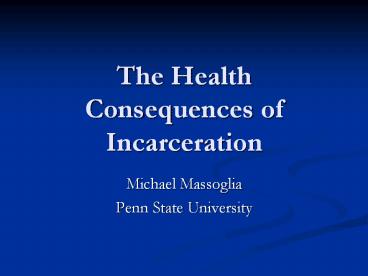The Health Consequences of Incarceration - PowerPoint PPT Presentation
Title:
The Health Consequences of Incarceration
Description:
The Health Consequences of Incarceration Michael Massoglia Penn State University – PowerPoint PPT presentation
Number of Views:143
Avg rating:3.0/5.0
Title: The Health Consequences of Incarceration
1
The Health Consequences of Incarceration
- Michael Massoglia
- Penn State University
2
2 Basic Questions
- Does incarceration affect later physical health?
- Does incarceration explain some of the racial
disparity in health between whites and nonwhites?
3
Mechanisms and Processes
- The correlates of health and crime are similar.
- Macro structures Inequality, poverty,
residential conditions. - Shaw and Mckay (1934)
- Life course markers Marriage, educational
attainment, income - Individual factors Substance use, risk taking
behavior
4
Spurious Associations
- Lifestyle theories
- Suggests an association may be evident, but a
function of lifestyle choices (i.e. drug use) and
therefore spurious - Personality theories
- Suggests an association may be evident, but a
function of underlying individual characteristic
(i.e. risk taking behavior) and therefore spurious
5
Linking Health to Incarceration Status
- Social Bonds and the Life Course
- Fractured bonds
- Living Conditions
- Exposure to disease and stress
- Social Hierarchy
- Societal participation and control over life
6
Racial Differences In Health
- One of the most persistent findings in the
literature indicates racial inequalities in
health - Whites have better health than minorities across
almost all indicators of health - Williams and Collins (1995) conclude that black
health functioning has worsened over the last 25
years - Blacks can expect to live fewer years while at
the same time living more of their life with
chronic disease (Hayward 1999) - Large scale systems of inequality are often used
to explain these persistent health differences
7
Incarceration in the United States
- Significant increase in rates of incarceration
over the last 25-30 years - Incarceration a phase in the life course for
some individuals, particularly poor minorities
(Pettit and Western 2004) - Risk of imprisonment Changes from 1979-1999
- Whites (1.4------2.9) Less than HS
(4.1----11.2) - Blacks (10.5----20.5) Less than HS (17.1---58.9)
8
Incarceration in the United States
- Correctional policies and the emergence of a new
felon class in society. Estimates indicate
this new class comprises - 7.5 percent of the adult population
- 22.3 percent of the black adult population
- 33.4 percent of the black adult male population
- (Uggen et al 2006)
9
Prisons and Inequality
- System of inequality?
- Prisons and stratification in the labor market
and earnings (Western and Beckett 1999 Western
2002 Pager 2003) - In the labor market, Pager concluded the mark
of a criminal record is more detrimental to
blacks - Disruption of the marriage market more severe for
blacks (Staples 1987 Wilson) - Irwin (1985) underclass of society
10
Prisons and Exposure
- National Commission on Correctional Health Care
report (2002) - Total HIV/AIDS 151,000-197,000 (20-26)
- Hepatitis B 155,000 (12-16)
- Hepatitis C 1.3-1.4 million (38)
- Tuberculosis outbreaks linked to correctional
institutions
11
Data
- National Longitudinal Survey of Youth (NLSY79)
- A comprehensive health module in the NLSY, given
to respondents at the age of 40 (N5556) - Dependent Variable Measure of physical health
functioning at age 40. - A composite indicator capturing a range of health
functioning taken from a widely used health
questionnaire (SF-12)
12
NLSY
- Equally divided between men and women, ages
40-44, 66 married. - 20 at or below 125 of poverty level.
- Approximately 75 white, average 13.7 years of
schooling, 81 in the labor force. - About 23 report binge drinking (5 drinks at one
time, 2-3 times a month) or cigarette use.
Slightly less than half the sample reports weekly
exercise. - Slightly more than 5 of the sample was
incarcerated, disproportionately minority.
Average time of incarceration about 34 months.
13
Basic Associations in Health
14
Health Values-Racial Differences
15
Two types of analysis
- Regression analysis with covariate adjustment
- Controls for prior health, life course markers,
and lifestyle indicators - Propensity models
- Account for differences across persons or groups
in the likelihood of experiencing a treatment - Rationale Non-random likelihood of experiencing
incarceration may bias the results generated from
OLS
16
Propensity Score Models
- Account for differences across persons or groups
in the likelihood of experiencing a treatment. - Rationale Non-random likelihood of experiencing
incarceration may bias the results generated from
OLS. - Average effects and standard estimator (Rosenbaum
and Rubin 1983 Winship and Morgan 1998). - The way individuals are assigned, or assign
themselves, to the treatment determines how
effectively the standard estimator estimates the
true effect. - Key assumption Assignment into treatment is
uncorrelated with outcome. - Tables.pdf
17
Discussion
- Incarceration is a powerful predictor of health
- Suggest incarceration impacts health multiple
ways - Disease and stress exposure
- Fractured social bonds
- Social hierarchy and social status
- Contributes to racial inequalities in physical
health
18
Implications for Policy
- Prison as part of the health care system.
- Much attention toward health care while in
prison. Yet little attention toward the long
term health implications. - Consequences of releasing 600,000 people a year
from prisons. - Prison programs that promote maintaining social
bonds. - Social policies that promote societal
reintegration - Education and workplace skills programs.
- Restoring the rights of inmates.
19
Directions for Future Work
- Short term vs long terms effects of incarceration
- Gender differences
- Regional or institutional variation
- Variation in mental health































